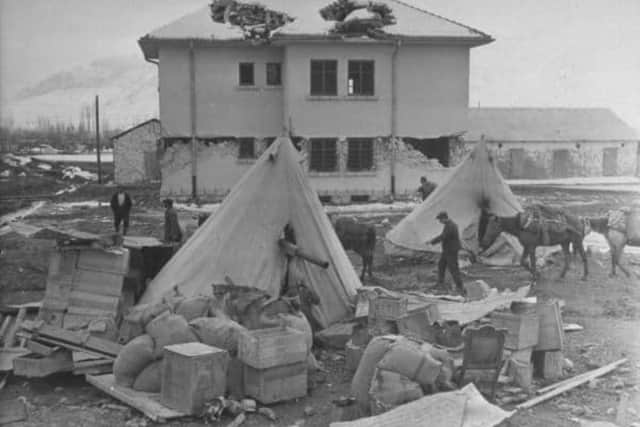Erzincan earthquake: 1939 Turkey disaster explained, how many died - how does it compare to 2023 quakes
and live on Freeview channel 276
The earthquake which struck southern Turkey and northern Syria on Monday (6 February) and claimed the lives of over 5,000 people may be the largest to ever strike Turkey.
Turkey sits on top of major fault lines and is frequently shaken by earthquakes. The majority of the nation is situated on the Anatolian tectonic plate, which is sandwiched between the Eurasian and African tectonic plates, and the Arabian tectonic plate. Turkey is effectively squeezed when the two huge plates shift, experts say.
Advertisement
Hide AdAdvertisement
Hide AdOther seismic events to have rocked the country include a powerful earthquake in December 1939, which also measured 7.8 on the Richter scale and killed 30,000 people in north-eastern Turkey.
The 1939 Erzincan earthquake is tied with the 2023 Turkey–Syria earthquakes as the second most powerful earthquake recorded in Turkey (topped only by the 1668 North Anatolia earthquake, which could have been as strong as magnitude 8.0). But what exactly happened, and just exactly how deadly was the incident? Here is everything you need to know.
What happened?


On Boxing Day 1939, Turkey was struck by one of the most devastating earthquakes in its history. A 7.8-magnitude earthquake struck the nation at 1:57am local time, leaving 8,000 people dead almost instantly.
The shaking lasted for 52 seconds, and caused visible scars along the Earth’s crust, many of which can still be seen today as surface ruptures. It is thought that up to 360 km (224 miles) of surface rupture was formed, shifting earth and rock by as much as two metres vertically, and 11 metres horizontally.
Advertisement
Hide AdAdvertisement
Hide AdAftershocks from the earthquake resulted in severe flooding and mudslides, and pushed a tsunami through the Black Sea, crashing down waves up to three metres in height around its coastline.
The top 10 most powerful earthquakes recorded in Turkey:
- 1668 North Anatolia earthquake (8.0)
- 1939 Erzincan earthquake (7.8)
- 2023 Turkey–Syria earthquakes (7.8)
- 1784 Erzincan earthquake (7.6)
- 115 Antioch earthquake (7.5)
- 1653 East Smyrna earthquake (7.5)
- 1840 Ahora earthquake (7.4)
- 1881 Chios earthquake (7.3)
- 1883 Çeşme earthquake (7.3)
- 1509 Constantinople earthquake (7.2)
How many people died?
The 1939 Erzincan earthquake was the most severe natural loss of life in Turkey in the 20th century, with a total of 32,968 dead as a direct result of the disaster, and some 100,000 injured.
How does it compare to the 2023 Turkey–Syria earthquakes?
The 1939 Erzincan earthquake is tied with the 2023 Turkey–Syria earthquakes as the second most powerful earthquake recorded in Turkey. Its total destruction prompted the Turkish government to adopt seismic building regulations.
Subsequent architectural advances go some way to account for why 2023’s (just as powerful) earthquakes have - at the time of writing - claimed fewer lives. Even more new building codes to protect against earthquakes in Turkey came into force in 2007 and 2019, including improvements to design supervision and site specific hazard definitions.
Advertisement
Hide AdAdvertisement
Hide AdSturdier buildings designed to withstand the jagged motion of an earthquake, coupled with general improvements in structure design mean that it’s likely fewer buildings will have completely collapsed during the 2023 disaster, trapping victims under rubble and debris.
For comparison’s sake, some 116,720 buildings are said to have been “seriously” damaged by the 1939 earthquake. Turkey’s government has confirmed that around 6,000 buildings have collapsed as a result of the 2023 earthquakes.
While we don’t know exactly what qualifies as a “seriously” damaged building in the case of the 1939 quake, we do know that the damage to the city of Erzincan was so extensive that it was entirely abandoned, and a new settlement was founded a little further to the north.
But what is likely to have accounted for the much greater death toll is the weather conditions surrounding the earthquake. Similarly occurring in winter, it was difficult for aid to reach the affected areas in 1939. 8,000 people were confirmed dead in the immediate aftermath of the earthquake, but the next day, that number had risen to 20,000.
Advertisement
Hide AdAdvertisement
Hide AdTemperatures had fallen to −30 °C during a particularly bitter winter as the emergency rescue operation began, and by 5 January, almost 33,000 people had died due to the earthquake and due to low temperatures, blizzard conditions and floods.
Why is Turkey hit with so many earthquakes?
In the 60 years that preceded 1939’s earthquake, 13 more 7+ magnitude quakes would rattle Turkey. Due to its location on several significant fault lines, Turkey experiences regular earthquakes.
The majority of the country is located on the Anatolian tectonic plate, which lies between the Eurasian and African tectonic plates as well as the Arabian tectonic plate. When the two enormous plates shift, Turkey is effectively crushed and squeezed between them, according to experts.
Comment Guidelines
National World encourages reader discussion on our stories. User feedback, insights and back-and-forth exchanges add a rich layer of context to reporting. Please review our Community Guidelines before commenting.
